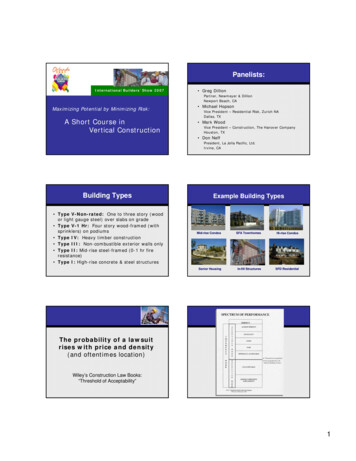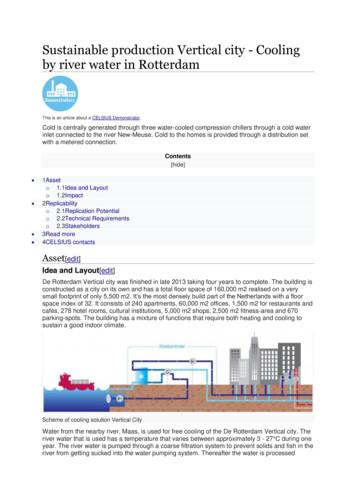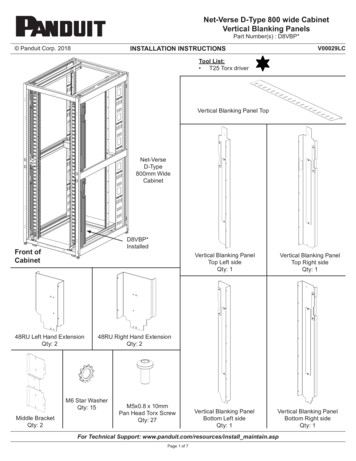
Transcription
Panelists:International Builders’ Show 2007 Greg DillionPartner, Newmeyer & DillionNewport Beach, CAMaximizing Potential by Minimizing Risk:A Short Course inVertical Construction Michael HopsonVice President – Residential Risk, Zurich NADallas, TX Mark WoodVice President – Construction, The Hanover CompanyHouston, TX Don NeffPresident, La Jolla Pacific, Ltd.Irvine, CABuilding Types Type V-Non-rated: One to three story (woodor light gauge steel) over slabs on grade Type V-1 Hr: Four story wood-framed (withsprinklers) on podiums Type IV: Heavy timber construction Type III: Non-combustible exterior walls only Type II: Mid-rise steel-framed (0-1 hr fireresistance) Type I: High-rise concrete & steel structuresExample Building TypesMid-rise CondosSFA TownhomesHi-rise CondosSenior HousingIn-fill StructuresSFD ResidentialThe probability of a lawsuitrises with price and density(and oftentimes location)Wiley’s Construction Law Books:“Threshold of Acceptability”1
IndemnitiesCONTRACT ISSUES Indemnities from:––––General contractorConstruction managerDesign professionalsSubcontractors Indemnities may be limited(20 states with significant limits, 13 with few or none) Indemnities should be backed by insurance Attorney feesINSURANCECommercial General Liability Traditional approach Wrap-up programsTraditional CGL Policies Contractors, subcontractors and designprofessionals each get their own policieswith varying terms, limits and deductiblesor self insured retentions Developer needs:– Certificates of insurance– Additional insured endorsements Operations only Completed operations Noticeor self Notice Noticeof applicable limits and deductibleinsured retentionof major exclusionsof cancellation or material changeWrap-Up Programs AKA an OCIP or a CCIP– OCIP – Owner Controlled Insurance Program– CCIP – Contractor Controlled Insurance Program A Wrap is a general liability policy that coversthe developer, general contractor and all tradecontractors (that are enrolled in the Wrap)under one shared policy2
Wrap-Up Benefits Broad, extensive coverageRelief of administrative overloadReduction of cross-litigation potentialSimplified claims responseProactive claims managementDuplications of coverage are not passed on tothe owner through the bid process General liability rate is fixed for term Cost savingsWrap-Up Benefits Provides the necessary insurance coveragethat subcontractors need but cannot obtain Allows builders to work on projects that theywould not otherwise be able to buildWrap-Up Considerations Construction term?Policy term?What limits are needed?Is defense within limits?How large an SIR or deductible?– Who will satisfy and how?Who defends within the SIR and how?How does the OCIP relate to the trade contractorswarranty and indemnity obligations?What happens if those covered by the OCIP program crossclaim against one another?If it is a conversion project, is prior work covered?Wrap-Up Considerations Major al liability (can cover professionals forBI/PD)– Insured vs. Insured (some exceptions)Other Insurance Coverages Builder’s Risk-All risk (of physical damage)EarthquakeFloodMaterials in transitTemporary off premisesSoft costs (interest expense/loss of rents) Professional Liability- Real estate sales E&O Pollution3
Scale:1 – 3 Unacceptable4 – 7 Acceptable8 – 10 ExcellentAttached ProductsYes/NoSafety and SecuritySoils and FoundationsFraming and MechanicalExterior and Interior FinishWater Intrusion ProtocolAttached ProductCOMMUNITYASSESSMENTPacificNorthwestPacific NorthwestWhat will I ask:Are you crazy?Yes7.839.6710.0010.0010.009.50Do you think I’m crazy?9.50A Little further west Inspections during construction by outsideexperts with photographic documentation Choice of structural wall board was an issue –rains caused standing water – wicking led to moldand revised building practices to stop the problemWhat will I ask: How big is the project – number of units, floors, buildings Do you have past experience with this type of building andproduct What surrounds this vertical subdivision Who are you key consultants– Acoustical and when in the process is he/she going to beengaged?– Architectural – peer review– Structural engineer– Geotechnical – did you get a second opinion?– 3rd party forensic inspection company? Scope of service for this firm Who is writing the building maintenance manual?Somewhere in the Middle of the US Condos – Our risk engineering scores have this project at a 8.04.So far, no losses related to the building envelope.GC used curing compound on the concrete floors to acceleratethe process which did lead to flooring issues – a bit over 1 millionto settle with the HOA.What will I ask: How long will you be attending the HOA meetings( in terms of years) HOA turnover plan How will the building be operated after turnover –professional property management firm? Water events – plan and training for youcustomer service people Document retention – what and how long4
RISK MANAGEMENT ISSUESQC vs. QA: What’s the difference? Quality Control: (short term view)– Just one component of Quality Assurance– Limited to specific program elements Plan review or Field observations orMaintenance manuals– Focuses on budget expense reduction Selected field assembly documentation at 50% sampling Water intrusion or framing or acoustical,etc. Driven by OCIP or CCIP requirementsQC vs. QA: What’s the difference?Organization for Success Quality Assurance: (long term view)– Expansive to encompass all program elements Plan review & Field observations & MaintenancemanualsAttention to DetailsExperience– Focuses on greater value added benefits Driven by Builder’s definition of quality (philosophy) 100% sampling of assemblies in 50% of units Requires organizational interventionsClient Expectations– Process training (design, purchasing, construction &delivery)– Technical training (all field risk elements)– Incentive benefit structure (in the office and field)– Pro-active document retention/archivingCommunicationYour Nightmare!Risk Management Paradigm: PeopleSystemsToolsTechnologyProject consisting of 200 condos with 1500 windowsPlaintiff experts perform a 1% test sample (15)Tests yield a 2/3 failure rate (10 of the 15)Experts extrapolate failure rate over entire project(1000 windows theoretically failing) Repair costs estimated at 1800 per window Claim is for 1,800,000 X 10 major trades Burden, expert, and attorney fees (add 50%) willmultiply cost impact for carrier and/or builder5
Litigation Generators Design errors and omissionsDelays and costs of such delaysDefective field work & accidentsField punch lists and poor close-outsWarranty/customer service follow-throughLack of homeowner maintenanceLack of HOA maintenance10 Key Questions1. What is the experience of the management team?2. What is the construction delivery system?3. What is the organizational structure?4. What contract documents are used?5. What previous legal issues have arisen?6. What are the construction department S.O.P.’s?7. How are design, specs, and purchasing managed?8. Which records are archived & under what system?9. How are C.S. policies implemented?10. What disclosure tools are used?Basic RelationshipsFour Areas of Builder Risk: Delivery System (Internal Organization)CustomerServicePeople &Training Owner/Builder (integrated or bifurcated) General Contractor (RFI communications) Design/Build (project may have 2 Engineers ofRecord) Project Team (External Organization)WorkmanshipDesign &PurchasingRisk Management byBuilding Type Building Architect (ASI communications)Structural, Mechanical & Acoustical EngineersCivil & Geo-technical EngineerLandscape ArchitectCommercial Trade ContractorsMaterial Suppliers & DetailersExample Building Types Type V Non-rated:One to three story overslabs on grade (water intrusion, structural/framing,concrete/foundations) Type V One-hour:Four-story, wood-framedon podiums over parking (water intrusion, acoustical,structural/framing, concrete/foundations, interiorfinishes, HOA common area maintenance)Mid-rise CondosSFA TownhomesHi-rise CondosSenior HousingIn-fill StructuresSFD Residential Type I, II:High-rise concrete and steel (waterintrusion, acoustical, HOA common area maintenance)6
Building Life Cycle of RiskManagement Concerns 1. Pre-construction risk management 2. Risk management throughout construction 3. Post-construction risk management2. During-Construction RiskManagement Selection of litigation generating assemblies Selection of field sampling percentages Observation & documentation of constructionprocess Tracking deficiencies & closing-up loose ends Training (theory & practice) & follow-up along theway (form & substance vital few or the trivialmany? ) Looking for quality trends by trade contractor Correcting deviations in process (Six Sigma/The 8thHabit/Freakonomics what are we incentivizing?) Archiving records for future litigation defense1. Pre-Construction Risk Management Thoroughly review your architectural plans for bothaccuracy and completeness of details Review your trade contractor scopes of work Specific attention to litigation generating items Combine value engineering & plan reviews by keyconsultants & trades in a group setting(design“charrette”) Document existing surrounding conditions at yourproject (existing buildings, homes, hardscape,softscape, etc.) Pre-conversion inspections (water intrusion,foundations, structure, sound, fire assemblies,common areas)3. Post-Construction Risk Management Deferred maintenance generates litigation“Tragedy of the Commons” definedProactively organize your turnovers (Phase I & II)Manage HOA expectations through ownership,board position, newsletters & ad-hoc meetingattendance Create & implement HOA common areamaintenance manuals with quarterly and annualinspections over time Create & implement homeowner manuals (inside) Successful condo converters needcustomer/warranty service organizationalinfrastructure (age of paper?)CONSTRUCTION ISSUES7
High-Rise ConcreteHigh-Density Stick - WrapGardenThe Question:How can we keep fromjeopardizing the assets of theCompany, while simultaneouslydelivering acceptable returns onour capital investment ?In the world of “for sale” multi-family realestate you expose your assets when you: Build an inferior or defective productWhen you fail to disclose required informationEngage in defective contractual agreementsFail to appropriately shed contractual riskHire the wrong people (who fail to perform)Allow others involved to be inadequatelyinsured Fail to document what to build correctly Fail to bring closure to documented problemsFrom the Wall Street Journal:Cover Story from January 9, 2007 regarding Mold suits.“Insurers and builders worried it would becomea liability disaster for them on the scale ofasbestos. The number of claims hasn’t beenas big as anticipated. One reason appears tobe the insurer’s success in getting many statesto exclude mold coverage from homeowner’sinsurance policies.”8
Strategies (continued)Hanover Risk Mitigation Strategies Tightly controlling the design process Hiring third party consultants for peer review,inspection, documentation, and systems testing Assigning construction management personnelfrom day one Continuingly reviewing “lessons learned” Intensive document coordination review Extensive use of mock-ups to perfect installations Buying early to hire more “quality”subcontractors Auditing our documented QA/QC procedures Conforming documents to reflect “as-built” conditions Rigorous contracting practices, including insurancerequirements Selective use of payment and performance bonds Use of GL Wrap Insurance in select markets Aggressively identifying issues requiring documentedclosure Collecting disclosure documentation from day one Engage third party to prepare litigation defense fromday one in select markets Enrolling our employees in the idea that these actionsand strategies create VALUE ( ) as perceived bythe marketplaceTheories of LiabilityLEGAL ISSUES Statutory Liability- Right to Repair Bills in 30 states:Alaska, Arizona, California, Colorado, Florida,Georgia, Hawaii, Idaho, Indiana, Kansas, Kentucky,Louisiana, Michigan, Minnesota, Mississippi, Missouri,Montana, Nevada, New Hampshire, North Dakota,Ohio, Oklahoma, Oregon, South Carolina, Tennessee,Texas, Virginia, Washington, West Virginia andWisconsin- Five more states are considering Right to Repair:Alabama, Illinois, Iowa, Massachusetts, and VermontTheories of Liability- Features can include: Absolute liability Recovery for code violations Statutes of repose (5 to 20 years – 29 states with 10years or more) No suit without giving builder the right to repair Breach of statutory warrantyTheories of Liability Breach of express warrantyBreach of fiduciary duty if controlled the HOANegligent misrepresentation and fraudNot properly licensedBreach of contractual indemnityEquitable indemnityEquitable contribution9
Theories of Liability Condominium Conversion Considerations– No strict liability for used products– No implied warranty for used products– Enhanced investigation and disclosurerequirements– Economic loss rule appliesQuestions &Answers 10
- CCIP - Contractor Controlled Insurance Program A Wrap is a general liability policy that covers the developer, general contractor and all trade contractors (that are enrolled in the Wrap) under one shared policy. 3 Wrap-Up Benefits Broad, extensive coverage











